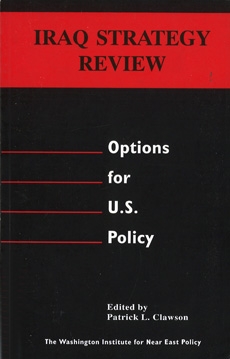|
PREFACE
More than seven years after the Gulf War, Saddam Husayn continues to flout UN Security Council resolutions with increasing frequency and boldness. Meanwhile, Washington struggles to hold together the Gulf War coalition and yet find some way to respond to Baghdad’s constant challenges. At the same time, many of America's allies arc growing restless with containment. Sanctions fatigue has set in and there are growing calls for the lifting of sanctions on Iraq. At home, many Americans are frustrated by Washington's inability to “get rid” of Saddam or to find a more permanent solution to the problem posed by Iraq.
Together, these forces have generated a heated debate in Washington over U.S. policy toward Iraq. Inside the government, leading politicians and diplomats are reexamining America’s Iraq policy to decide whether it should be bolstered or changed. On the outside, experts, analysts, and commentators of every persuasion provide voices offering new strategies toward Iraq.
The problem with Iraq is that, like many foreign policy issues, each option entails advantages and disadvantages, costs, risks, and tradeoffs. The key for policy makers and for the American people is to decide which policy offers the best possibility of securing U.S interests in the Persian Gulf. To answer that question, one must understand what each policy would entail. Unfortunately, snappy slogans and empty phrases too often substitute for analysis of policy options. Iraq Strategy Review is designed to try to fill this gap.
Iraq Strategy Review introduces a new type ef publication from The Washington Institute. In response to the debate over Iraq policy, the Institute commissioned five experts to delve into the range of strategies the United States could pursue. Each of the essays in this volume looks at a different potential approach America can take toward Iraq. Each of these essays provides a detailed analysis of the option, focusing on its strengths, its weaknesses, and the requirements to implement it. Each of these essays is presented as if in response to the question, “How could the United States implement this policy?”
Iraq Strategy Review is intended as a guide for perplexed policymakers charged with improving or changing America’s current Iraq policy. Each option is examined in detail, but none is specifically endorsed. That is because the purpose of this exercise is to inform the policy debate, not to direct it. While reaffirming the merits of prescriptions offered in other Institute publications— including the 1996 final report of the Presidential Study Group — we present Iraq Strategy Review with the more modest hope that, it might provide a solid foundation on which to build future policy toward a vitally important issue.
Mike Stein
President
Barbi Weinberg
Chairman
Contributors
Daniel L. Byman is a policy analyst with the RAND Corporation specializing in Middle East politics, the use of aerospace power, and terrorism. He has served as a Persian Gulf political analyst at the Central Intelligence Agency.
Michael J. Eisenstadt is a senior fellow at The Washington Institute. He is the author most recently of ‘Knives, Tanks, and Missiles’: Israel's Security Revolution (Washington Institute, 1998).
John Hillen is the Olin Fellow for National Security Studies at the Washington office of the Council on Foreign Relations. A former U.S. Army reconnaissance officer and paratrooper, he fought in the 1991 Persian Gulf War with the Second Armored Cavalry Regiment.
Andrew Parasiliti is director of programs at the Middle East Institute. He specializes in Iraqi politics and Persian Gulf security issues.
Kenneth M. Pollack is a research fellow at the Washington Institute specializing in political and military affaire of the Persian Gulf States. He has worked in Near East and South Asian affaire at the National Security Council and was a Persian Gulf military analyst at the Central Intelligence Agency.
Rethinking Iraq Strategy
Why and How?
Patrick L. Clawson
Iraq has been a continuing problem for U.S. policy, as was brought home during the November 1997-February 1998 crisis. Whereas much dissatisfaction was heard about the current policy, the popular debate exposed the difficulties with alternative courses of action. The aim of this study is to flesh out that policy debate by presenting the detailed case for each of the policy alternatives.
Reviewing the Present Situation
The challenge posed by Iraq for U.S. policy has some enduring éléments, but it has also changed rather significantly in the last two years.
What Has Remained the Same?
Iraq under President Saddam Husayn continues to pose a major challenge to Middle East peace and stability. As Bruce Riedel, the National Security Council’s senior director for Near East and South Asian affairs, told The Washington Institute, “We ail know it is not over. Saddam Husayn’s track record is ail too clear. He will continue to challenge the international commu-nity because his goals remain régional domination and revenge for past defeats. That is why he started two warf and tried to assassinate President Bush and the émir of Kuwait.”1
Nothing brings out more sharply the severity of the Iraq threat than the issue of weapons of mass destruction (WMD) and the missiles with which to deliver them. Whereas many nations hâve WMD arsenals, Iraq is the only one with a recent …
| 